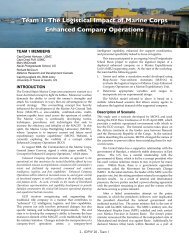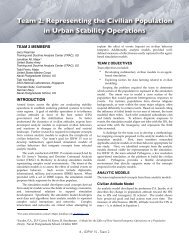pdf file - SEED Center for Data Farming - Naval Postgraduate School
pdf file - SEED Center for Data Farming - Naval Postgraduate School
pdf file - SEED Center for Data Farming - Naval Postgraduate School
You also want an ePaper? Increase the reach of your titles
YUMPU automatically turns print PDFs into web optimized ePapers that Google loves.
the course of the 72 simulated hours) and interactions with<br />
METOC conditions. Comparing the six pirate density plots<br />
would result in 15 pairwise comparisons.<br />
Potential summary statistics<br />
We considered summary statistics <strong>for</strong> comparing two<br />
maps of pirate density (whether they were from the same time<br />
period, and different design points, or the same design point,<br />
but different time periods). The following Y-variables were<br />
used in our experiment:<br />
• The maximum root mean square cell-by-cell difference<br />
(RMSE) between each design point and all other design<br />
points. RMSE especially penalizes large errors.<br />
• The cell-wise maximum difference (MaxDiff) in pirate<br />
density between each design point and all other design<br />
points<br />
• For each trial, the largest RMSE between a 12hr pirate<br />
density and the 72-hour averaged pirate density map<br />
(this response variable is called !RMSE, and analogous<br />
measures are !MaxDiff and !50th prctile)<br />
• The mean across time-periods of the area that bounds<br />
50% of the pirate density (50th prctile).<br />
• Same as each of the above, but <strong>for</strong> smoothed<br />
distributions (indicated by S-prefix).<br />
Other summary statistics that we considered, and which<br />
might be applicable in future work include:<br />
• Cell-by-cell differences in mean relative entropy.<br />
• Location: minimum distance between two modes (or<br />
sum of minimum 2 or 3 distances).<br />
• Decision-related<br />
- How much of the total pirate density can be captured<br />
within miles of optimally deployed search assets?<br />
- How big would circular covering disk have to be to<br />
capture 75% of the pirate density?<br />
- Sum of differences over larger (“coarse-grained”)<br />
cells that might be defined according to the size of an<br />
area searchable by Task Force 151 assets within a<br />
given time?<br />
• Other:<br />
- Fourier trans<strong>for</strong>m<br />
- Max eigenvector<br />
Experimental Design<br />
Because the current implementation of the simulation is<br />
in Matlab, and there<strong>for</strong>e we expected each trial to take an<br />
hour or two to run, we knew we would be limited in the<br />
number of design points. To capture the effects of all variables<br />
and interactions among them, we used a Nearly Orthogonal<br />
Latin Hypercube (NOLH) design (Cioppa & Lucas, 2007),<br />
downloaded from <strong>SEED</strong> center website. We restricted<br />
ourselves to experiment with eleven input variables (Xvariables),<br />
which allowed us to use an experimental design<br />
with 33 design points, which we anticipated was few enough<br />
that we could complete the runs overnight. The variables and<br />
their maximum and minimum values are shown in Table 1<br />
below.<br />
Variable<br />
Minimum Maximum<br />
Simulated pirates per day 200 1200<br />
Mission length (hours), Length 72 120<br />
Pirate groups 3 7<br />
Total number of land and sea bases* 3 7<br />
Proportion of bases that are sea 0.25 0.5<br />
bases*<br />
Known base locations (Yes/No) No Yes<br />
Transit speed (kts), Speed 8 12<br />
Pirates' wind threshold (kts, Wind 10 20<br />
Pirates' wave threshold (ft),Wave 3 10<br />
Probability that pirates use <strong>for</strong>ecasts 0 1<br />
Wind drift factor, Drift 0.1 0.75<br />
*Used to calculate number of<br />
land bases (Camps) and sea bases (Sea Bases)<br />
Table 1: Input variables (X) used in the experiment<br />
RMSE S-RMSE MaxDiff !RMSE S-!RMSE !MaxDiff !S-MaxDiff 50 th -prctile<br />
S-50 th<br />
prctile<br />
0.77 0.68 0.38 0.55 0.77 0.66 0.84 0.73 0.71<br />
Length × Length Speed × Wind Wave Wave Wave Length Length<br />
Wind<br />
Drift<br />
Wave 2 Wind Drift Wave Wind Wind Wave 2 Wind Wind<br />
Wave Wave Speed Camps × Sea Bases Camps Sea Bases Speed<br />
Wave<br />
Drift Length ×<br />
Camps Sea Bases × Wind Speed Sea Bases<br />
Wind<br />
Wave<br />
Wind Wave 2 Camps ×<br />
Wind<br />
Sea Bases ×<br />
Speed<br />
Camps ×<br />
Drift<br />
Camps<br />
Length<br />
Table 2: For each output measure, adjusted R2 and input variables included in the<br />
fitted regression model, ordered from most to least influential.<br />
52 - IDFW 20 - Team 14




